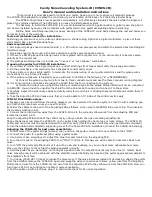
©
National Instruments Corporation
11
NI 5731/5732/5733/5734R User Guide and Specifications
9.
Set the
Trigger Level (V)
and the
Record Size
controls to the desired value.
10. In the
Trigger Type
control, you can select either
Software Trigger
or
Data Edge
. If you select
Software Trigger
, the VI acquires data every time you click the
Software Trigger
button on the
front panel of the VI. If you select
Data Edge
, the VI acquires data every time an edge occurs.
11. Set the
Sample Rate
control to the default sample rate of your device.
Note
The
Sample Rate
control does not change the sample rate of your device; it only adjusts the
time display.
12. Click the
Run
button to run the VI.
13. Click the
Software Trigger
button if you selected
Software Trigger
in the
Trigger Type
control.
The VI acquires data and displays the captured waveform on the
Acquired Waveform
graph as
shown in Figure 5.
14. Click the
STOP
button to stop the VI. Close the VI.
Figure 5.
NI 573
x
- Getting Started (Host) VI Front Panel
Note
(NI 5731 Only)
ESD events can affect the NI 5731 Sample clock, which can cause error
-50400
when performing DMA transfers or result in other clock performance and timeout errors
when acquiring data on the NI 5731. To ensure that the NI 5731 self-recovers from this error, the host
and FPGA VIs must be able to trap these timeout errors and reinitialize the FPGA. The following two
steps describe how to self-recover the NI 5731:
1.
For more information about how to trap the error, visit the KnowledgeBase at
ni.com/kb
, enter
3BPD5HRY
, and select the article,
Ignoring a Particular Error in an Error Cluster in LabVIEW
.
2.
To reinitialize the FPGA, refer to the
Reset (Invoke Method)
topic in the
NI FPGA Module Help
file, available in LabVIEW and at
ni.com/manuals
.
Содержание NI 5734
Страница 1: ...NI 5734...













































